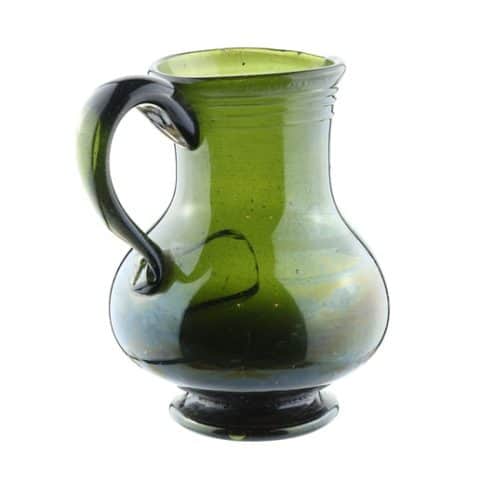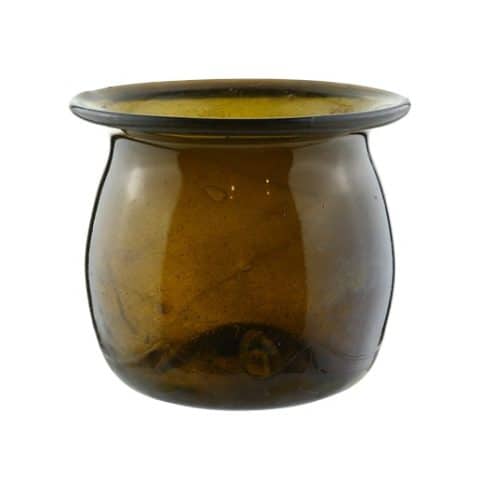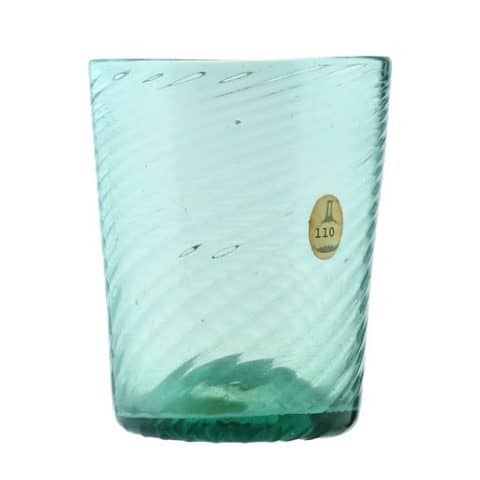New England Blown Pitcher
New England Freeblown Pitcher
Tableware
Possibly Coventry Glass Works, Coventry, Connecticut
Olive Milk Jug or Pitcher
Provenance: Richard S. Ciralli Collection

This fine specimen in our Early American Glass Wing – Free Blown & Pattern Molded Gallery – Tableware Room represents a New England Freeblown Milk Jug or Pitcher. This rare piece was possibly made at the Coventry Glass Works in Coventry, Connecticut, between 1820 and 1848.

The 6-inch tall olive pitcher has a large bulbous body flaring to the rim, with a large applied solid glass ear handle, applied solid glass circular foot, and fine neck threading. The olive glass pitcher is crisp and clear with a distinct pour spout and pontil scar. The provenance is ex Norman Heckler Jr. collection.
There were five successful glasshouses in the eastern portion of the state of Connecticut. The earliest was the Pitkin family glassworks which originated in 1783 and closed about 1830. The others, in order of organization, were the Coventry Glass Works at Coventry; the Willington Glass Works at West Willington; the New London Glass Company Works at New London; and the factory of the Westford Glass Company of Ashford. These Connecticut glasshouses were located in close vicinity of each other.
See the museum example of a similar Freeblown Pitcher possibly made at Willington Glass Works in West Willington, Connecticut.
Primary Image: New England Freeblown Pitcher imaged on location by Alan DeMaison, FOHBC Virtual Museum Midwest Studio.
Support: Reference to American Glass by George S. and Helen McKearin, Crown Publishers Inc., New York, 1989.
Support: Reference to American Bottles and Flasks and Their Ancestry by Helen McKearin and Kenneth M. Wilson, Crown Publishers, New York, 1978.
Support Image: Auction Lot 167: Early Freeblown Pitcher, possibly Coventry Glass Works, Coventry, Connecticut, 1830-1848. Bulbous body flaring to rim, large applied ear handle and fine neck threading, yellowish olive with an amber tone, tooled flared rim with pour spout – pontil scar, ht. 6 inches, base dia. 3 inches; (1 inch fissure at upper handle attachment, chips under and around lower handle attachment). Similar in form and construction to McK plate 71a, #6. A wonderful piece of early New England blown tableware with a pleasing size and form. – Norman Heckler Jr. & Sr., Norman C. Heckler & Company, Auction #170
Support Image: Auction Lot 236: Freeblown Pitcher, Coventry Glass Works, Coventry, Connecticut, 1820-1848. Cylindrical with short shoulder flaring to tooled flared rim, applied solid handle, medium to deep olive amber, tooled flared mouth with pour spout – pontil scar, ht. 6 inches, greatest dia. 4 1/4 inches; (large crack runs from rim around lower handle attachment and back up to shoulder, 1/2 inch fissure at upper handle attachment). Similar in form to KW fig. 88, right A note which reads “This pitcher is guaranteed to be Coventry glass. It was bought around 1920 from John Carpenter of North Coventry and was blown by one of his ancestors. So he said.” accompanies the pitcher. – Norman Heckler Jr. & Sr., Norman C. Heckler & Company, Auction #158
Support Image: Auction Lot 78: Early Freeblown Pitcher, New England, probably Coventry Glass Works, Coventry, Connecticut, 1820-1860. Bulbous body with a wide flared rim and pour spout, large applied ear handle and fine neck threading, yellowish olive, outward rolled rim – pontil scar, ht. 6 inches, base dia. 3 inches; (chips under and around the applied lower handle attachment). Beautiful form, great handle, nicely executed piece of New England tableware. – Norman Heckler Jr. & Sr., Norman C. Heckler & Company, Auction #98
Join the FOHBC: The Virtual Museum is a project of the Federation of Historical Bottle Collectors (FOHBC). To become a member.































